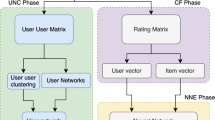Abstract
Collaborative filtering is a successful approach in relevant item or service recommendation provision to users in rich, online domains. This approach has been widely applied in commercial environments with success, especially in online marketing, similar product suggestion and selection and tailor-made consumer suggestions. However, regardless of its market penetration, there are still considerable limitations in terms of accuracy in the proposed recommendations stemming from the high-frequency low-relevance user-item bias, data specificities and individual user patterns and needs that may be hidden in data. We propose a novel recommendation approach that improves accuracy and requires significantly less maintenance compared to traditional collaborative filtering. For the experimental evaluation, we use two real data sets and well-known metrics with the results validating our method. Our proposed method outperforms all the alternative recommendation methods for each of the two data sets and metrics and seems holistically effective against alternatives since it requires fewer settings to be considered without affecting the output.



Similar content being viewed by others
References
Alshammari G, Kapetanakis S, Polatidis N, Petridis M (2008) A triangle multi-level item-based collaborative filtering method that improves recommendations. In: International conference on engineering applications of neural networks, 2018, Sep 3, Springer, Cham, pp 145–157
Aggarwal CC et al (2016) Recommender systems. Springer, Berlin
Alshammari G, Jorro-Aragoneses JL, Kapetanakis S, Petridis M, Recio- Garcfa JA, Diaz-Agudo B (2017) A hybrid CBR approach for the long tail problem in recommender systems. In: International conference on case-based reasoning, Springer, Berlin, pp. 35-45
Bobadilla J, Ortega F, Hernando A, Gutierrez A (2013) Recommender systems survey. Knowl Based Syst Recomm Syst Surv 46:109–132
Burke R (2002) Hybrid recommender systems: survey and experiments. User Model User-Adapt Interact 12(4):331–370
Gedikli F, Jannach D (2010) Recommending based on rating frequencies: accurate enough? In: Proceedings of the 8th workshop on intelligent techniques for web personalization and recommender systems at UMAP lO (ITWPlO), pp 65–70
Goldberg D, Nichols D, Oki BM, Terry D (1992) Using collaborative filtering to weave an information tapestry. Commun ACM 35(12):61–70
Harper FM, Konstan JA (2016) The movielens datasets: history and context. ACM Trans Interact Intell Syst (TiiS) 5(4):19
Herlocker JL, Konstan JA, Borchers A, Riedl J (1999) An algorithmic framework for performing collaborative filtering. In: Proceedings of the 22nd annual international ACM SIGIR conference on research and development in information retrieval, ACM, pp 230–237
Herlocker JL, Konstan JA, Terveen LG, Riedl JT (2004) Evaluating collaborative filtering recommender systems. ACM Trans Inf Syst (TOIS) 22(1):5–53
Jeong B, Lee J, Cho H (2010) Improving memory-based collaborative filtering via similarity updating and prediction modulation. Inf Sci 180(5):602–612
Katarya R, Verma OP (2017) Effectual recommendations using artificial algae algorithm and fuzzy c-mean. Swarm Evolut Comput 36:52–61
Konstan JA, Riedl J (2012) Recommender systems: from algorithms to user experience. User Model User Adapt Interact 22(1–2):101–123
Mikolov T, Karafiat M, Burget L, Cernocky J, Khudanpur S (2010) Recurrent neural network based language model. In: Eleventh annual conference of the international speech communication association
Miller BN, Albert I, Lam SK, Konstan JA, Riedl J (2003) Movielens unplugged: experiences with an occasionally connected recommender system. In: Proceedings of the 8th international conference on intelligent user interfaces, ACM, pp 263–266
Polatidis N, Georgiadis CK (2016) A multi-level collaborative filtering method that improves recommendations. Expert Syst Appl 48:100–110
Resnick P, Iacovou N, Suchak M, Bergstrom P, Riedl J (1994) Grouplens: an open architecture for collaborative filtering of netnews. In: Proceedings of the 1994 ACM conference on computer supported cooperative work, ACM, pp 175–186
Sarwar, B., Karypis, G., Konstan, J., Riedl, J.: Item-based collaborative filtering recommendation algorithms. In: Proceedings of the 10th international conference on world wide web, ACM, pp 285–295
Shen K, Liu Y, Zhang Z (2017) Modified similarity algorithm for collaborative filtering. In: International conference on knowledge management in organizations, Springer, Berlin, pp 378–385
Shi Y, Larson M, Hanjalic A (2014) Collaborative filtering beyond the user-item matrix: a survey of the state of the art and future challenges. ACM Comput Surv (CSUR) 47(1):3
Sun SB, Zhang ZH, Dong XL, Zhang HR, Li TJ, Zhang L, Min F (2017) Integrating triangle and Jaccard similarities for recommendation. PLoS ONE 12(8):e0183570
Tan Z, He L (2017) An efficient similarity measure for user-based collaborative filtering recommender systems inspired by the physical resonance principle. IEEE Access 5:27211–27228
Wei S, Zheng X, Chen D, Chen C (2016) A hybrid approach for movie recommendation via tags and ratings. Electron Commer Res Appl 18:83–94
Yoshii K, Goto M, Komatani K, Ogata T, Okuno HG (2008) An efficient hybrid music recommender system using an incrementally trainable probabilistic generative model. IEEE Trans Audio Speech Lang Process 16(2):435–447
Weston J, Wang C, Weiss R, Berenzweig A (2012) Latent collaborative retrieval. In: International conference on machine learning (ICML), Edinburgh, Scotland, June
Author information
Authors and Affiliations
Corresponding author
Ethics declarations
Conflict of interest
The authors declare that they have no conflict of interest.
Additional information
Publisher's Note
Springer Nature remains neutral with regard to jurisdictional claims in published maps and institutional affiliations.
Rights and permissions
About this article
Cite this article
Kapetanakis, S., Polatidis, N., Alshammari, G. et al. A novel recommendation method based on general matrix factorization and artificial neural networks. Neural Comput & Applic 32, 12327–12334 (2020). https://doi.org/10.1007/s00521-019-04534-w
Received:
Accepted:
Published:
Issue Date:
DOI: https://doi.org/10.1007/s00521-019-04534-w




